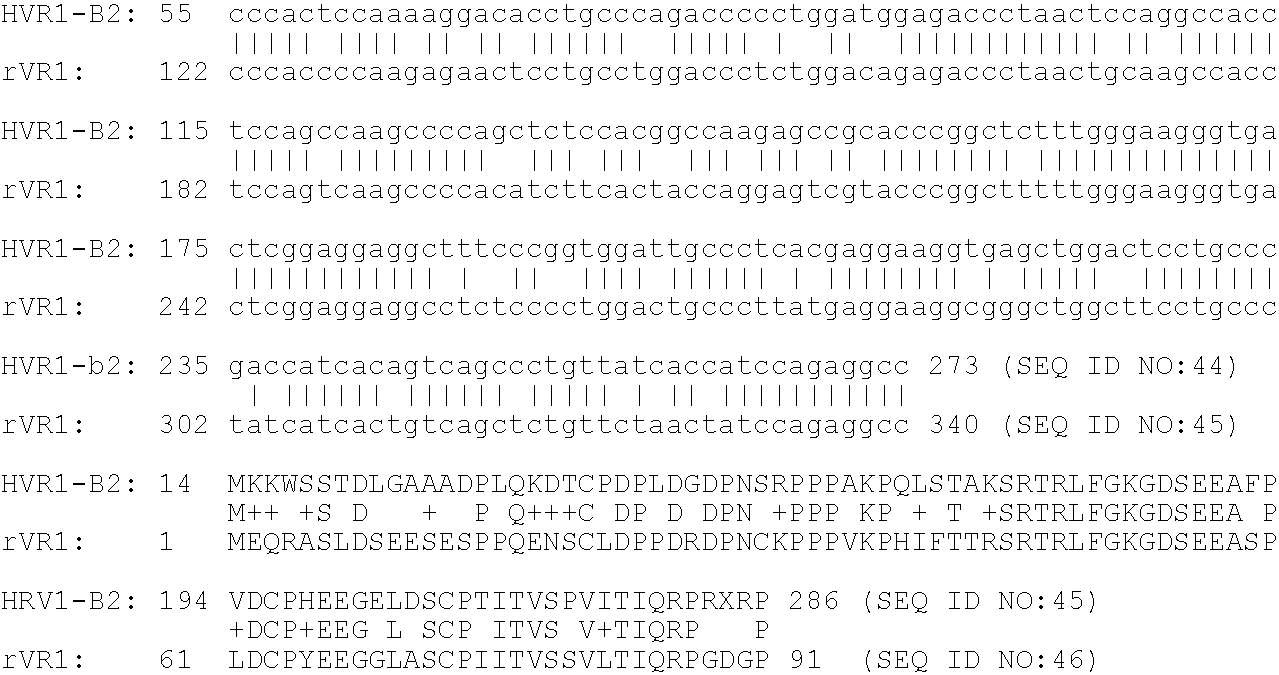Nucleic acid sequences encoding capsaicin receptor and capsaicin receptor-related polypeptides and uses thereof
a technology of capsaicin receptor and amino acid sequence, which is applied in the field of amino acid sequence encoding capsaicin receptor and capsaicin receptor related polypeptides, can solve the problems of difficult to rule out the possibility, affecting the development of elegant systems for screening or characterizing new capsaicin receptor-binding compounds, and affecting the identification of endogenous, tissue-derived mediators of pain and/or inflammation
- Summary
- Abstract
- Description
- Claims
- Application Information
AI Technical Summary
Benefits of technology
Problems solved by technology
Method used
Image
Examples
example 1
Expression Cloning of Rat Capsaicin Receptor-Encoding DNA
[0176]While electrophysiological assays in Xenopus oocytes have been employed to obtain cDNAs encoding a variety of cell surface receptors and ion channels (Brake et al. 1995 Nature 371:519–523), this approach proved unsuccessful in identifying a capsaicin receptor clone. A mammalian cell expression cloning strategy based on the ability of capsaicin to trigger an influx of calcium ions into sensory neurons was developed. First, a rodent dorsal root ganglion plasmid cDNA library was constructed in pcDNA3 (Invitrogen) essentially as described (Brake et al., supra). A mixture of polyadenylated RNA from newborn (P1) rat and adult mouse dorsal root ganglia was used to generate first-strand cDNA using an oligo (dT) primer containing a Not1 restriction site. Following second strand synthesis and attachment of BstX1 adaptors, the cDNA was digested with Not1. cDNA and BstX1 / Not1-linearized pcDNA3 were each purified on potassium acetate...
example 2
Sequencing and Characterization of Capsaicin Receptor-Encoding cDNA
[0180]The 3 kb cDNA insert was sequenced using an automated sequencer (ABI). Homology searches were performed against the nonredundant Genbank database and against an EST database (dbest) using blastn, blastx, and tblastx search programs. Hydrophilicity was calculated using the Hopp-Woods algorithm and a window size of ten 47. The insert was determined to be of rat origin by sequencing an independent cDNA isolated from a rat DRG library and a PCR product derived from mouse DRG cDNA. The sequence of the isolated rat capsaicin receptor-encoding polynucleotide (SEQ ID NO:1) and its corresponding amino acid sequence (SEQ ID NO:2) are shown in FIG. 1. Because a vanilloid moiety constitutes an essential chemical component of capsaicin and resiniferatoxin structures, the proposed site of action of these compounds is more generally referred to as the vanilloid receptor (Szallasi 1994 Gen. Pharmac. 25:223–243). Accordly, the ...
example 3
VR1 does not Function as a Store-Operated Calcium Channel (SOC)
[0184]The amino acid sequence similarities between VR1 and SOCs suggested that the capsaicin receptor might function as an SOC. To test this, calcium-dependent inward currents were examined in VR1-expressing, intracellular calcium-depleted oocytes according to methods well known in the art.
[0185]Briefly, cRNA transcripts were synthesized from Not1— linearized VR1 cDNA templates using T7 RNA polymerase 17. Defolliculated Xenopus laevis oocytes were injected with 0.5–5 ng VR1 cRNA. Four to seven days after injection, two electrode voltage clamp recording was performed (Ehold=−60 mV for IC50 curve and thermal stimulation experiments and −40 mV for all other experiments) using a Geneclamp 500 amplifier (Axon Instruments) and a MacLab A / D converter (Maclab). The recording chamber was perfused at a rate of 2 ml / min with frog ringers solution containing (mM) 90 NaCl; 1.0 KCl, 2.4 NaHCO3, 0.1 BaCl2, 1.0 MgCl2, and 10 HEPES, pH 7...
PUM
| Property | Measurement | Unit |
|---|---|---|
| voltage | aaaaa | aaaaa |
| voltage | aaaaa | aaaaa |
| pH | aaaaa | aaaaa |
Abstract
Description
Claims
Application Information
 Login to View More
Login to View More - R&D
- Intellectual Property
- Life Sciences
- Materials
- Tech Scout
- Unparalleled Data Quality
- Higher Quality Content
- 60% Fewer Hallucinations
Browse by: Latest US Patents, China's latest patents, Technical Efficacy Thesaurus, Application Domain, Technology Topic, Popular Technical Reports.
© 2025 PatSnap. All rights reserved.Legal|Privacy policy|Modern Slavery Act Transparency Statement|Sitemap|About US| Contact US: help@patsnap.com



